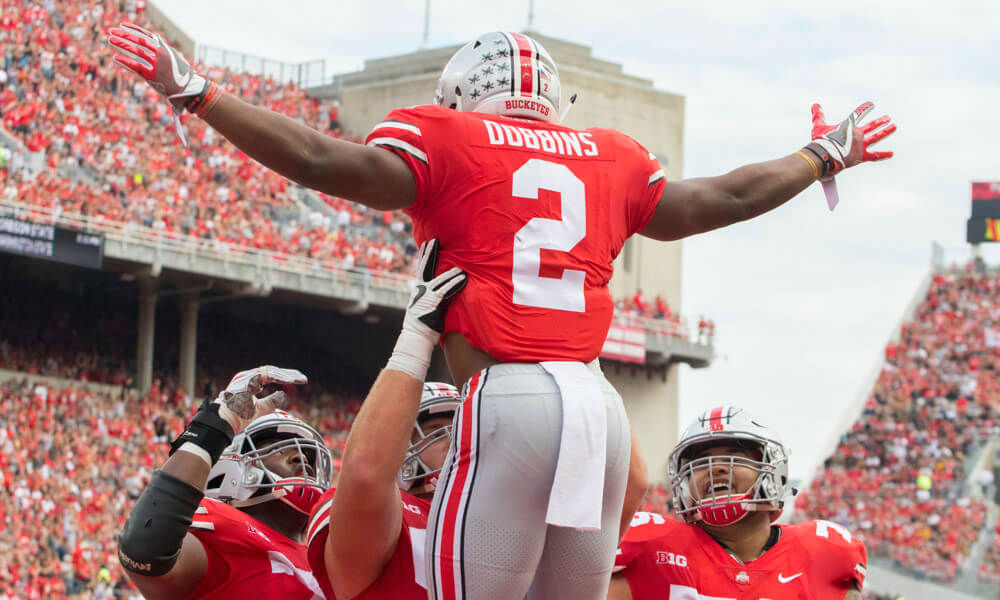Former Ohio State great Woody Hayes once said, “……I will pound you and pound you until you quit.” For years, that has been the mantra of Ohio State football. Whether it’s Howard Cassady, Archie Griffin, Eddie George or Ezekiel Elliott, running backs have been the dominant factor behind nearly every Ohio State championship-winning team.
Last week against Iowa, Ohio State abandoned that mentality, and it clearly showed. The Buckeyes rushed only 30 times and attempted 34 passes. They were blown out 55-24. Ohio State has passed more than it has rushed only THREE times this season, and two of those have been losses. Last season, the Buckeyes’ two games with the fewest rushes came against Penn State and Clemson, both losses.
This past Saturday, Ohio State returned to its normal roots. The No. 13 Buckeyes handed the football off  42 times and only attempted 23 passes. The result? A 48-3 blowout of the No. 12 Michigan State Spartans. I don’t want to sound like a broken record, but that’s the Buckeye way! Run the ball straight down their mouth.
42 times and only attempted 23 passes. The result? A 48-3 blowout of the No. 12 Michigan State Spartans. I don’t want to sound like a broken record, but that’s the Buckeye way! Run the ball straight down their mouth.
Head Coach Urban Meyer said Monday that he had a conversation with running backs coach Tony Alford and co-OC Kevin Wilson about running the ball more often. After the game, Meyer seemed to take a slightly different angle when he said there was a “mandate” to make sure his running backs were fed the ball. The reason the offense relied more heavily on the backs this Saturday than against Iowa was the result of dictating the flow of the game. Freshman running back J.K. Dobbins said that after their first practice last week, it became crystal clear what they were planning on doing.
Dobbins makes it sound simple, but on paper, the matchup appeared to be anything but simple. Going into a game, Michigan State’s rushing defense had allowed the third-fewest rushing yards per game and fourth-fewest yards per carry; Ohio State had their work cut out for them. Nonetheless, Ohio State seemed determined right out of the gate to test that defense with Dobbins and redshirt sophomore Mike Weber.
Six plays into Ohio State’s first offensive drive of the game, Weber took the handoff from Barrett, made it three yards past the line of scrimmage and left the Spartans in a cloud of dust. He raced 47 yards up the middle and into the end zone. It would not be the last time Weber picked up a touchdown with a big rush. He later burst into the end zone with 6:27 remaining in the second quarter for a career-long 82-yard rush to put the Buckeyes up 35-0.
By the time the burnt rubber had settled, Weber had finished the game with 162 yards and two  touchdowns on nine carries, while Dobbins had 124 yards on 18 rushes. During the game, Dobbins joined Weber, Maurice Clarett, and Robert Smith as the only Ohio State freshmen to rush for more than 1,000 yards in a season. Only Dobbins, Clarett and Smith were true freshmen.
touchdowns on nine carries, while Dobbins had 124 yards on 18 rushes. During the game, Dobbins joined Weber, Maurice Clarett, and Robert Smith as the only Ohio State freshmen to rush for more than 1,000 yards in a season. Only Dobbins, Clarett and Smith were true freshmen.
Ohio State found that good things happen when it leans on its explosive pair of running backs. This shouldn’t be breaking news for a program that has historically relied on the ground game (I will preach that fact from the highest mountaintop).
Of the eight retired numbers in Ohio State history, only Troy Smith fits the modern classification of a quarterback. Five of the numbers are those of running backs. Though Ohio State has always counted on quarterbacks in some capacity, the Buckeyes have usually been a program that has often viewed passing as a risk rather than the backbone of the offense.
Against Iowa, Ohio State threw the ball frequently, and the results were REALLY bad. The Buckeyes avoided that Saturday against the Spartans, resulting in their biggest margin of victory over MSU in history and one of their most dominating wins of the season.




